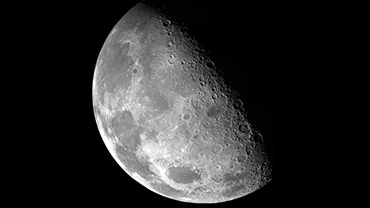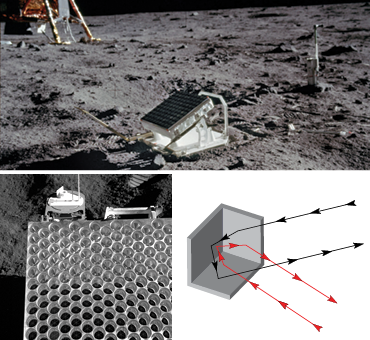Apollo astronauts left trash, mementos and experiments on the moon
50 years later, the experiments still teach us things and the trash needs to be preserved
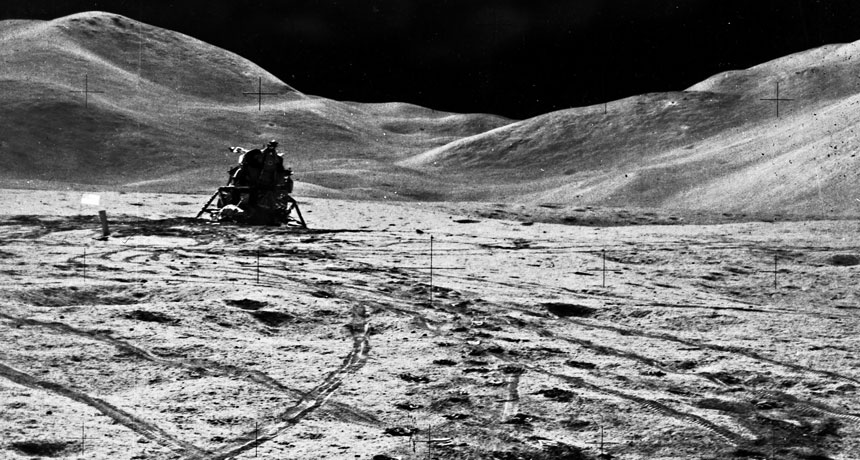
LUNAR LEFTOVERS Astronauts, like those who touched down in the Apollo 15 lunar module (shown) in July 1971, left a lot on the moon’s surface, from scientific instruments to trash.
NASA
Once on the moon, Apollo astronauts had two major goals: get themselves and the moon rocks home safe.
To make space on the cramped lunar modules for the hundreds of kilograms of moon samples, the astronauts had to go full Marie Kondo. Anything that wasn’t essential for the ride home got tossed: cameras, hammocks, boots and trash. Downsizing also meant abandoning big stuff, like moon buggies and the descent stage that served as a launchpad for a module’s lunar liftoff.
But the astronauts left more than castoffs. Starting with the Apollo 11 mission, which touched down on July 20, 1969, astronauts left six American flags and plenty of personal and political mementos. Importantly, the crews also left behind instruments for about a dozen experiments to keep tabs on lunar conditions (SN: 8/2/69, p. 95); one is still running today.
These devices “were really important parts of Apollo,” says Noah Petro, project scientist for the Lunar Reconnaissance Orbiter mission. Back then, the experiments didn’t get much time in the limelight, “because humans on the surface are obviously the big story,” says Petro, who is based at NASA’s Goddard Space Flight Center in Greenbelt, Md.
When we think of Apollo’s 50-year legacy, most of us probably aren’t picturing the scattered remnants of astronaut outposts gathering space dust. But as nations plan new ventures to the moon, preservationists are fighting to protect these historic sites so that future lunar visitors don’t erase the marks of humans’ first steps beyond Earth.
Solving old mysteries
By December 1972, six Apollo crews had collectively spent nearly 80 hours exploring the moon’s surface (SN: 12/23/72, p. 404). They gathered rocks, photographed the landscape and performed all manner of experiments — from unfurling metal foil to catch solar wind particles to setting off explosives and measuring the resulting seismic tremors.
Apollo 11 left behind solar-powered seismometers and a reflector array that could be paired with lasers on Earth to precisely measure the distance between Earth and the moon. On five later missions, Apollo 12 through 17 (Apollo 13 returned home without landing on the moon), astronauts left more elaborate setups powered by nuclear batteries that generated electricity through radioactive decay (SN: 11/8/69, p. 434). Some of those instruments collected data through 1977, when NASA decided to focus on other projects and pulled the plug on the whole operation (SN: 10/1/77, p. 213).
“There was this period of time where the data languished,” Petro says. But within the last decade or so, a new generation of scientists has taken up the torch, analyzing Apollo observations to answer questions lingering from early studies. Unfortunately, this isn’t nearly as simple as picking up where 1970s scientists left off, as geophysicist Seiichi Nagihara discovered when he set out to solve a decades-old puzzle about the moon’s underground temperature.
On Apollo 15 and 17, astronauts installed thermometers in the lunar surface, which took the moon’s temperature at various depths and sent the data back to Earth (SN: 9/11/71, p. 167). When Apollo-era scientists reviewed data collected through 1974, the results revealed something odd: The moon’s temperature just beneath the surface appeared to be slowly rising.
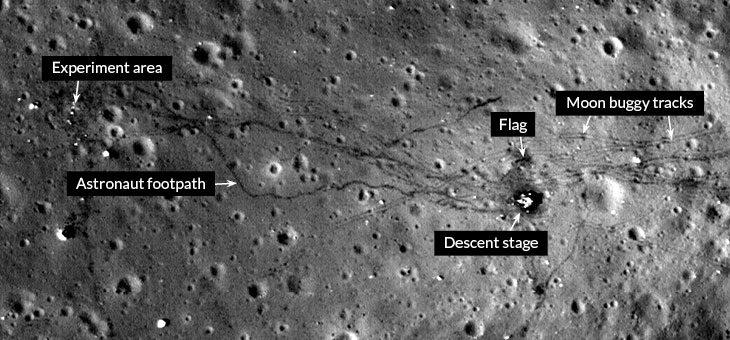
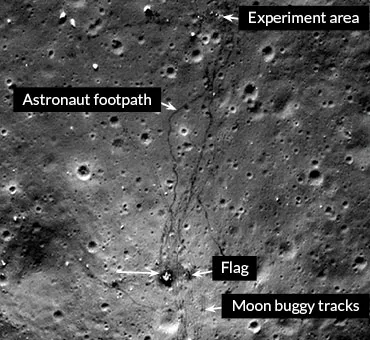
“We’re talking about very minor warming,” just a couple degrees, says Nagihara, of Texas Tech University in Lubbock. But researchers at the time couldn’t figure out why. Nagihara decided to examine all the temperature data collected through 1977 to figure out what was going on. Unfortunately, the tapes that recorded these measurements were missing. This is a common problem, because during the Apollo era, data were housed at the individual labs of scientists working on each experiment and many measurements were never properly archived.
“A group of us decided to … try to hunt down the tapes,” Nagihara says. After scouring thousands of documents at NASA’s Johnson Space Flight Center in Houston, the researchers traced 440 tapes to an archive in Suitland, Md. But even those covered only about three months of observations. At the Lunar and Planetary Institute in Houston, Nagihara and colleagues discovered more temperature measurements noted by Apollo-era scientists in weekly memos. Between the recovered tapes and the memos, Nagihara’s team pieced together a picture of the moon’s temperature from 1971 through 1977.
The slow warming under the surface continued through the end of data collection, the researchers reported in April 2018 in the Journal of Geophysical Research: Planets. In search of a source for the heat, Nagihara and colleagues turned to pictures taken by the Lunar Reconnaissance Orbiter, which has been orbiting the moon since 2009 (SN: 6/11/16, p. 10). The images showed that soil stirred up by astronaut activity was slightly darker than other lunar terrain. Perhaps it was dark enough to absorb more sunlight and warm the underlying ground.
Computer simulations confirmed that the moon wasn’t heating up from internal processes. Astronauts trekking around the Apollo sites probably caused an increase in surface temperature of about 2 to 3 degrees Celsius, and the extra heat slowly spread more than a meter into the ground — causing the gradual warming detected by Apollo instruments. Turns out that astronaut footsteps left marks on the moon far deeper than those iconic boot prints.
Keeping vigil over gravity
While Nagihara and other researchers are digging up old Apollo data for new analyses, one lone project is still in full swing: the laser ranging retroreflector experiment.
This experiment uses arrays of reflectors placed on the moon by Apollo 11, 14 and 15 astronauts and anchored on two rovers left behind by the Soviets (SN: 5/20/78, p. 326). These arrays consist of special mirrors, each with three sides in the shape of a cube’s corner, which always reflect light in the exact direction from which it came. By shooting a laser beam at a corner-cube array from a telescope on Earth and clocking the time it takes for the light to return, researchers can measure the exact distance between different spots on the moon and Earth.
Laser ranging retroreflector measurements have offered several insights — like the fact that the moon is withdrawing from Earth at about 3.8 centimeters per year. Plus, slight variations in the moon’s rotation suggest that the orb has a relatively small core.
Physicist Tom Murphy of the University of California, San Diego is using the corner-cube arrays to probe a question much bigger than the moon. He’s testing whether a key part of Einstein’s general theory of relativity, called the equivalence principle, holds up.
The equivalence principle states that any two objects in the same gravitational field should fall at the same rate (SN: 1/20/18, p. 9). Just like a bowling ball and a golf ball should hit the ground simultaneously, the Earth and moon should fall around the sun (that is, orbit the sun) at exactly the same rate. “You’re sensitive to any difference in how they’re [orbiting] the sun by measuring the distance between the Earth and moon as they weave around each other,” Murphy says. If the Earth-moon distance ultimately breaks with the equivalence principle, that would reveal a shortcoming of general relativity. And that, in turn, could inform the creation of a theory of quantum gravity that resolves the tension between general relativity and quantum mechanics (SN: 10/17/15, p. 28).
So far, laser ranging retroreflector measurements with centimeter-level precision haven’t shown any difference in how quickly the Earth and moon are falling around the sun. But in 2006, Murphy started collecting data with millimeter-scale precision using improved laser technology and a larger telescope at the Apache Point Observatory in New Mexico.
Amassing enough data will require several more years of observation and researchers will need more sophisticated computer models to analyze the observations, Murphy says. Luckily, since the reflectors on the moon don’t require any power, he can collect data into the foreseeable future. Eventually, those observations — at the millimeter level or even smaller scales — could reveal a crack in the equivalence principle.
Since general relativity is fundamentally incompatible with quantum mechanics, something eventually has to give. The equivalence principle might be one of those things, Murphy says. “We have to turn over every rock and see where the bugs are.”
One astronaut’s trash
Thermometers and reflectors were among about a dozen types of instruments installed on the moon. Other devices measured the moon’s magnetic field and sniffed out chemical components of the moon’s tenuous atmosphere. NASA’s Lunar Data Project is restoring data from these and other Apollo experiments, so that scientists can continue to pore over the observations for years to come.
“When you have this incredibly rare resource, you can’t not keep working on it,” says planetary scientist Renee Weber of NASA’s Marshall Space Flight Center in Huntsville, Ala., who studies lunar seismic data. “There are always new techniques to try” and better computer processing to tease out previously missed signals.
Based on moonquakes sensed by Apollo seismometers, Weber and colleagues reported in May that the moon may still be tectonically active, as revealed by young faults on the lunar surface called lobate scarps (SN: 6/8/19, p. 7). Understanding moonquakes could help NASA and other agencies decide where to land future spacecraft or construct buildings on the moon, Weber says. If these lobate scarps truly mark sites of tectonic activity, future lunar visitors may want to avoid them, she says.
There’s also plenty to learn by testing how well the Apollo instruments, as well as the nonscientific paraphernalia strewn across the lunar surface, have held up. All of that stuff has been exposed to the lunar elements for decades. Future expeditions could sample the detritus to get a sense of how human communities might one day fare on the moon.
“Every single thing at the sites would be a completely priceless scientific investigation,” says planetary scientist Philip Metzger of the University of Central Florida in Orlando. He can imagine scrutinizing the effects of ultraviolet radiation, solar wind and other factors on everything from batteries to camera lenses to towels and earplugs.
Metzger sees value in everything left behind on the moon, including the astronauts’ discarded bags of excrement. “We have studies of microbes lasting in space over very short amounts of time on the International Space Station,” he says, but testing whether microbes in astronaut waste have survived or mutated over the last 50 years could help determine whether life is up to the challenge of hopping between planets or even solar systems. These are “really important questions about the position of life in the cosmos,” he says.
Protecting Apollo
While Metzger and other space scientists are hoping Apollo remnants can teach us more about how humans would fare on the moon, Beth O’Leary and other archaeologists are hoping to preserve these items as testaments to the human endeavor of getting there.
“Space is not a vacuum. We carry our culture into it,” says O’Leary, of New Mexico State University in Las Cruces. The remnants of Apollo sites are important relics of a singular time in human history. Astronaut memorials, messages of peace and commemorative plaques on the moon are obvious pieces of heritage. But “even the scientific stuff has cultural importance,” she says. More than 400,000 space-age Americans at over 20,000 companies and universities across the country teamed up to put Apollo astronauts on the moon. That kind of mass collaboration, in itself, was “a cultural act, as well as a scientific or engineering feat,” O’Leary says.
Unfortunately, securing legal protections for the historical preservation of Apollo sites isn’t easy. Don’t expect the United States to establish an Apollo National Park on the moon any time soon. As fun as that sounds, it would violate the Outer Space Treaty of 1967, which states that no nation can claim sovereignty over the moon’s surface.
NASA has published guidelines on how to avoid ruining Apollo artifacts in preparation for the many countries and companies that are vying for parking spots on the moon (SN: 11/24/18, p. 14). This rulebook includes policies such as the distance a future lunar spacecraft should land from Apollo sites so that the rocket exhaust doesn’t wipe Neil Armstrong’s first boot print off the face of the moon. These guidelines aren’t legally binding, Metzger says, but “no company is going to want to be known as the company that ruined one of the Apollo sites.”
Michelle Hanlon, who specializes in space law at the University of Mississippi in Oxford, has her sights on a much broader agreement to protect Apollo sites. Her nonprofit, For All Moonkind, is seeking United Nations protections for relics on the moon. The U.N. Committee on the Peaceful Uses of Outer Space is “the ideal place to negotiate a new treaty on heritage in space,” Hanlon says, though she suspects it may take decades to reach such an international deal.
By then, many more people than professional astronauts may be walking the moon, fueling concerns about visitors making off with Apollo artifacts. In 2015, a lunar sample bag used by Armstrong was mistakenly sold at a government auction for $995 and later resold for $1.8 million. Other space-age memorabilia has sold for similarly astronomical prices.
“If NASA can lose [Armstrong’s] bag, how can they keep track of all the artifacts” once people begin making regular round trips to the moon? Hanlon asks. “You can imagine [looters] going up and just grabbing artifacts and bringing them back to sell.”
It’s not just Apollo artifacts Hanlon wants to see preserved. Earlier this year, China let the first rover loose on the farside of the moon (SN: 2/2/19, p. 5), and Israel crash-landed its first spacecraft on the lunar surface (SN Online: 4/11/19). “These are all wildly important milestones” in humankind’s quest to touch the stars that deserve to be preserved, Hanlon says.
